

While the best possible raw images are always desired, image processing can do wonders. See Antonio Cidadao's or Thierry Legault's home pages for excellent examples. In fact, their images are so spectacular, they were hard to believe! To demonstrate the power of Cidadao's technique, I used a series of test images of Jupiter and Saturn, and processed them the same way.
During some initial camera tests, I acquired some images of both Saturn and Jupiter at F/6. At this focal ratio, the planets only spanned 30-40 pixels, far from the optimum value for high resolution imaging. This is a severe test, and is only a demonstration of the power of the technique.
Nine individual images were taken (in less than one minute) of Jupiter ( 0.1 second) and Saturn (0.7 seconds) through a green (IR blocked) filter, so chromatic aberration and tracking errors were negligible. The exposures filled the camera's pixel wells with about 40,000 counts, so each pixel has a good signal-to-noise ratio. To improve pixel alignment, nine individual images were first resampled to enlarge the images by a factor of three. Before combining the images, each raw image was then processed with an unsharp mask. To improve the signal-to-noise ratio even further, the nine consecutive images were summed, using the location of a conveniently placed moon close to the planet for manual alignment. Tests showed that this additional summing is critical to reduce the noise in the subsequent processing.
The following images show first a single raw image of Jupiter (converted to jpg, so much of the dynamic range is lost). The next image is the sum of the nine images. The last image is improved even further with maximum entropy processing. Its hard to believe that this image started out like the first raw image!
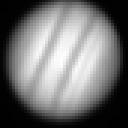
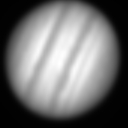
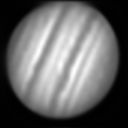
The Saturn processing was similar. The nine images were first combined, then the unsharp mask applied to the image. The first image here is the raw data, then the combined, pre-processed image. The final image shows processing with both unsharp masking followed by maximum entropy deconvolution. Again, the final result is a testament to the power of image processing. Processing the individual raw images with maxent or unsharp masking does not produce as good a final image.
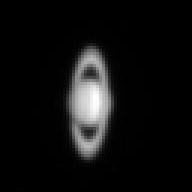
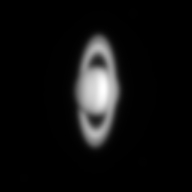
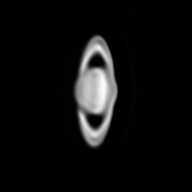
When the Stellar Products observatory is fully operational, images at F/60 will be taken with near perfect tracking, high speed image stabilization, and hopefully under good seeing conditions with a diffraction-limited telescope. With a little luck, the results will justify the upgrade to a 16" telescope!
All text and images are owned by Stellar Products, 1992-2003. Any use by others without permission of Stellar Products is prohibited.
Links to other Stellar Products pages: